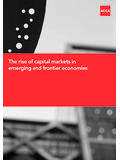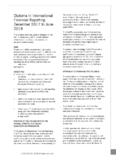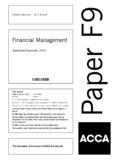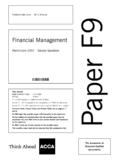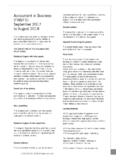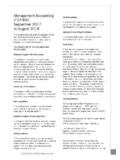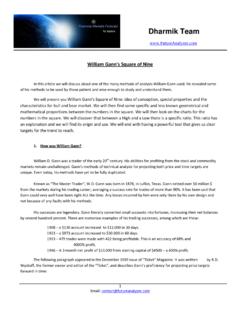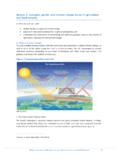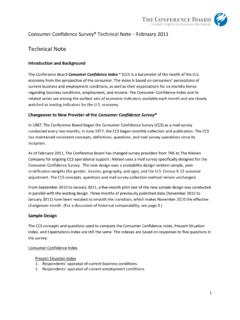Transcription of Answers - ACCA Global
1 Answers Professional Level Options Module, Paper P5. Advanced Performance Management June 2013 Answers 1 Report To: CEO. From: A. Accountant Date: June 2013. Subject: Balanced scorecard and targets at Kolmog Hotels Introduction This report explains the differences between service and manufacturing industries and evaluates the current board performance information. Next, it evaluates the proposed balanced scorecard and describes the difficulties in implementing and using it. Finally, the purpose of setting challenging targets is explained and the hotel managers' standards and rewards are evaluated using the building block model. (i) Characteristics differentiating service from manufacturing businesses The service nature of the hotel business can be analysed as: simultaneous in that the service is created as it is consumed during the customer's stay.
2 Heterogeneous (variable) in that it is hard to standardise the service since each hotel and city stayed in is different;. intangible in that there is no physical product, only nights' stay in the hotel. This is a cause of the low cost of sales at 12% of revenue;. perishable in that hotel nights cannot be stored as they are used that night. Thus, in the hotel industry room occupancy is often a key performance measure; and there is no transfer of ownership as the guest's stay only gives them right of access to use the hotel facilities for a limited period. (ii) Current strategic performance information The current information used by the board is purely financial in nature and, as a result, it omits to measure many of the elements mentioned in the mission.
3 It covers the shareholder value aspects through EPS growth, share price performance and ROCE, although there are arguably better measures of shareholder value in total shareholder return and economic value added. However, it does not quantify customer and employee loyalty nor product innovation, which are the routes by which the primary mission is to be achieved. Most strikingly, there is also no attempt to measure the goal of being the No. 1 hotel chain in Ostland. An obvious way to measure this would be market share but there is no external data given in the report. The use of ratios comparing to revenue is a helpful communication tool in showing how resources/costs generate sales but, again, no external comparators are given which would aid in judging competitive position.
4 The breakdown of results into geographical areas is only helpful if these are comparable. A breakdown of the results by hotel type may be a more useful management tool, as luxury hotels will use a higher staff to guest ratio than budget ones and the geographical results will be distorted unless each geographical area has the same mix of these different product types. Year on year growth figures are given but no inflation figure is given which might explain growth as a non-management achievement. There is limited information on fixed and variable costs in the report which is relevant to Kolmog, as hotels naturally have high operational gearing since many costs (financing, property, staff and administration) are fixed and so profit is sensitive to small changes in revenues.
5 There are a number of traditional measures of hotel performance that would improve the report by helping to capture this issue, such as occupancy rates and revenue per available room. Finally, the report does not link to the budget which appears to be the main operational control tool. Summary budget figures and variances may aid the board in their role of overseeing performance. (iii) BSC proposal Generally, the BSC will aid in communicating, implementing and controlling the strategy of the company. It aims to help achieve coherence between the stated goals and the measures used at Kolmog. The proposed scorecard has the advantage of using only a limited number of measures and so should avoid the danger of information overload.
6 Taking each perspective in turn: The financial perspective is covered by the measures of strategic financial performance (share price and ROCE). This fits with the objective of maximising shareholder value. It is also common to use dividend per share as well as share price to reflect total shareholder return. Return on capital employed is a standard measure of overall performance but this may now have less value for Kolmog. The change in strategy in no longer owning the hotels that it operates will reduce the capital dependence of the business. It may be more appropriate to use a measure such as operational gearing (fixed costs/total costs). that reflects the returns against fixed costs (especially rental payments). Revenue growth will also be an important measure of the achievement of being the leading hotel chain in Ostland.
7 15. The customer perspective is addressed by the customer survey scores. This addresses the objective of delighting customers. However, there is no direct attempt to measure the objective of improving brand loyalty. The customers are a major stakeholder whose loyalty Kolmog will want to improve. Growth in returning customers ( repeat business) would be better measured, for example, through growth in customer account revenues. The internal process perspective is addressed through the hotel budget variance analysis. This analysis will need to be broken down into detailed areas for each hotel. It may be necessary to have different areas of emphasis depending on the hotel type, for example, country house hotels will have different occupancy levels from city centre ones due to the seasonality of this trade.
8 Benchmarking performance against these internal comparators should assist in spreading best practice within the chain. This communication of best practice may help to instil brand loyalty among employees if they feel that other members of the chain are helping to improve their own hotel's performance. The learning and growth perspective would appear to be an obvious area to address, given the objective on product innovation. Yet there is no measure given for this. A possible metric would be percentage of revenue generated from new hotel types or hotel services. Hotels are a fairly mature business and so this may be a difficult objective to realise. Instead, the objective of employee loyalty is addressed by measuring staff turnover.
9 The happiness and motivation of staff is likely to be a key driver of the customer experience and so it has been highly prioritised. This can be measured through surveys of staff attitudes. In relation to all the measures proposed, Kolmog should benchmark their performance against their competitors. This will measure whether they are achieving the No. 1' status that is the primary objective. (iv) Difficulties of implementing and using the BSC. The first difficulty is in selecting the metrics for use in the scorecard. It is important that the BSC does not become a long list of metrics that obscure the truth with information overload. It is important to measure what is needed to be measured, not just what can be measured.
10 There is often difficulty with measuring the innovation and learning perspective and other qualitative/non-financial areas. There is also the need to translate the strategic measures down to the operational level, for example, breaking down general customer satisfaction into specific areas of customer interaction such as reception and room service. The second difficulty is that some of the perspectives and their metrics will naturally conflict with each other. For example, reducing employee turnover may require increasing their pay but this will conflict with profit targets. These conflicts may be required to be resolved at board level by looking at what will achieve the overall mission of the company. The third difficulty is that the use of many metrics requires managers to be capable of interpreting each metric and also handling the volume of metrics presented.




